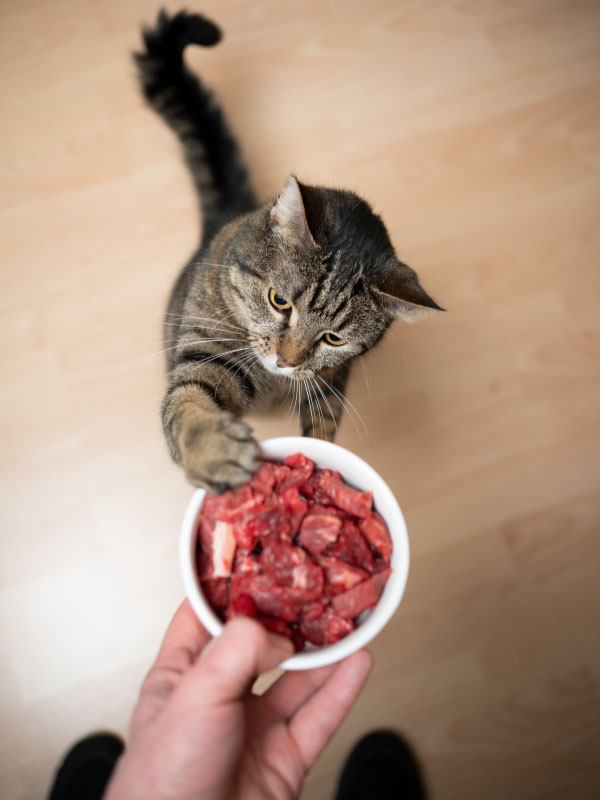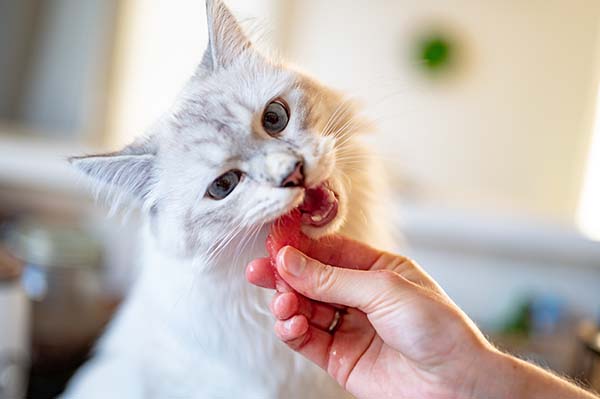In a world where obesity is a growing concern, it's not just humans facing the battle of the bulge. Our feline companions are also grappling with weight issues, and it's time to address this burgeoning problem. The challenge of assisting cats in achieving a healthy weight is an important issue that demands thoughtful and attentive management.
In this blog post, we will discuss why it's important to shed those extra pounds, how you can help your cat lose weight, and, most importantly, effective strategies to help our cats shed those excess pounds. From understanding the science behind weight loss to practical tips and expert advice, this comprehensive guide aims to provide cat owners with the knowledge and tools necessary to embark on a journey towards a healthier, happier life for their feline friends.
Reasons To Help Overweight Cats Lose Extra Pounds
Helping your overweight cat shed those extra pounds is not just a matter of aesthetics; ensuring their overall health and well-being is crucial. Here are some compelling reasons to address cat obesity:
Decreased Mobility: Excess weight can make it difficult for your cat to move comfortably, jump, or play. Decreased mobility can result in a sedentary lifestyle, worsening the issue of weight gain.
Lower Energy Levels: Overweight cats often have lower energy levels, which can affect their playfulness and interaction with you and other pets in the household.
Increased Risk of Surgery Complications: If your cat needs surgery, excess weight can elevate the risk of complications both during and after the procedure.
Reduced Lifespan: Studies have shown that overweight cats tend to have shorter lifespans compared to cats at a healthy weight.
Happiness: A trimmer, healthier cat is often happier, with increased energy and playfulness.
Overweight cats face an elevated risk of various health issues and complications. Here are some of the health risks:
Diabetes: Obesity significantly increases the risk of cats developing diabetes mellitus. The surplus body fat can disrupt insulin function, producing heightened blood sugar levels.
Heart Disease: Cats that are overweight or obese are at an increased risk of developing heart diseases, including hypertension (high blood pressure) and cardiomyopathy (heart muscle disease).
Joint Issues: The additional weight puts extra strain on the joints, resulting in conditions such as arthritis and reduced mobility. Joint pain can further reduce a cat's activity level.
Respiratory Problems: Obese cats can have difficulty breathing and may be at higher risk for conditions like feline asthma.
Urinary Tract Disease: Obesity can contribute to developing urinary tract problems, including urinary tract infections and feline lower urinary tract disease (FLUTD).
Hepatic Lipidosis: Also referred to as fatty liver disease, is a serious condition characterized by the accumulation of excess fat in the liver. It can be life-threatening, particularly in overweight cats that cease eating.
Skin Issues: Obese cats may have skin problems due to difficulty grooming themselves, leading to matting, skin infections, and dermatitis.
Digestive Problems: Gastrointestinal issues like constipation and diarrhea are more common in obese cats.
Reduced Lifespan: Obesity can markedly reduce a cat's lifespan. Overweight and obese cats face an increased risk of premature death compared to their lean counterparts.

How To Help Cats Lose Weight
Consult a Veterinarian
Before embarking on a weight loss journey for your cat, it's crucial to consult your veterinarian. During this visit, your vet will comprehensively assess your cat's current health, considering factors such as age, breed, and overall condition. They will set a target weight, which will serve as a goal to work towards. Based on their evaluation, your veterinarian will recommend a specific weight loss plan with dietary and exercise guidelines tailored to your cat's unique needs.
Regular Feeding Schedule
Creating a consistent feeding schedule with designated mealtimes is essential for effective weight management. Refrain from the practice of free-feeding, where food is available throughout the day, as it can complicate portion control and monitoring your cat's intake. By adhering to a regular feeding schedule, you can better manage your cat's calorie consumption.
Portion Control
Implementing portion control is a fundamental element in managing your cat's weight. To ensure accurate feeding, measuring your cat's food portions precisely is essential. This can be done using a kitchen scale or a measuring cup. Avoid estimating portions, as it can lead to overfeeding. To ascertain the correct portion size, adhere to the feeding guidelines outlined on the food packaging or as your veterinarian recommends.
Choose a Weight Management Diet
Your veterinarian may recommend switching your cat to a specialized weight management diet. These diets are meticulously formulated to offer essential nutrients while minimizing calorie intake. They often contain higher fiber content to help your cat feel full and satisfied despite consuming fewer calories. Following your vet's recommendations regarding the specific diet that best suits your cat's weight loss goals is essential.
In addition, switching from dry food to wet food can be an effective strategy to help your cat lose weight safely. Wet food generally contains a higher water content, aiding in making your cat feel satisfied with fewer calories. Moreover, wet food often has lower carbohydrate levels, contributing to a reduced overall calorie intake.
The elevated moisture content in wet food can also enhance hydration, a crucial element for overall health that can aid in weight loss efforts. Cats often don't drink enough water alone, so getting moisture from their food can be beneficial.
Furthermore, wet food is frequently more appealing, facilitating better control over portion sizes and preventing overconsumption. When shifting to wet food, it's essential to seek advice from your veterinarian to choose the appropriate diet and manage portion sizes, ensuring a safe and gradual weight loss process for your cat.
Increased Activity
Increasing your cat's activity level is a crucial component of the plan to help your cat lose weight. Interactive playtime is a top strategy; engage your cat daily with toys like feather wands, laser pointers, or interactive toys that mimic prey. These activities simulate hunting, keeping your cat physically engaged.
Additionally, consider cat trees or climbing structures to encourage climbing and exploration, as well as obstacle courses made from boxes and tunnels. Outdoor enclosures or leash training can offer supervised outdoor adventures. Food puzzles and treat-dispensing toys make mealtime interactive, and hide-and-seek games for treats promote physical activity. Spend quality time with your cat for social interaction, fostering a strong bond and encouraging activity.
Always introduce new activities gradually and consult your veterinarian to align the exercise routine with your cat's health needs, as increased activity supports both weight loss and overall well-being.
Monitor Progress
Regular monitoring of your cat's progress is essential to gauge the effectiveness of the weight loss plan. Use a digital scale to weigh your cat consistently and track their weight loss journey. If you notice any unexpected weight changes or concerns, promptly discuss them with your veterinarian. Adjustments to the feeding plan may be necessary based on your cat's response to the weight loss program until it reaches its ideal weight.
Hydration
Proper hydration is a key aspect of overall feline health. Make sure your cat has continual access to fresh water. Staying adequately hydrated supports the body's natural processes and can aid in weight management.
Patience and Consistency
Embarking on your obese cat's weight loss journey requires patience and consistency. Understand that weight loss takes time, and every cat's progress is unique. Celebrate small milestones and maintain a steady course, even when faced with challenges. Consistency in following the plan is key to achieving long-term success.
Regular Veterinary Check-ups
Continuing to schedule regular check-ups with your veterinarian is crucial throughout the weight loss process. These visits allow your vet to closely monitor your cat's progress, make any necessary adjustments to the weight loss plan, and address any health concerns that may arise.

Tips To Help Your Cat Lose Weight
Slow, Gradual Weight Loss
Rapid weight loss can have adverse effects on your cat's health. Aim for gradual reductions in weight to ensure a safe weight loss journey. A generally accepted rate of weight loss is around 0.5-2% of your cat's body weight per week. Employing a gradual method helps reduce the potential for complications linked to swift fluctuations in weight.
Avoid Treats and Table Scraps
Limiting or eliminating high-calorie treats and table scraps from your cat's diet is essential to prevent excessive calorie intake. Although indulging your cat with treats can be an enjoyable way to acknowledge their behavior, choosing low-calorie cat treats in moderation is advisable. The accumulation of high-calorie snacks and table scraps may impede your cat's efforts in achieving weight loss goals.
Use a Treat Toy or Feeding Ball
Depending on your cat's weight loss process, you can treat your cat here and there. Incorporating a treat toy or feeding ball into your cat's routine can aid in weight loss. These interactive devices dispense small amounts of food as your cat plays with them, promoting physical activity and mental stimulation. By making mealtime engaging and challenging, these toys slow down calorie consumption and prevent overeating. When your cat engages in activities to obtain their food, they expend calories, contributing to maintaining a healthier weight. It's an effective way to combine entertainment with portion control for a feline friend on a weight loss journey.
Consider Using A Slow Feeder or Food Puzzle
Swap your traditional food bowl with a slow feeder or food puzzle. Food puzzles and slow feeders serve a dual purpose for cats—they provide mental stimulation and help with weight loss by limiting the amount of food your cat eats. Interactive devices necessitate cats to seek and work for their food actively, stimulating their problem-solving skills and helping to prevent overeating.
By slowing down mealtime, they reduce the risk of rapid calorie consumption. This supports effective portion control and promotes a sense of satisfaction in cats, even when consuming smaller amounts.
As cats play with these devices to access their food, they become mentally and physically active, contributing to weight management and overall well-being. Incorporating food puzzles or slow feeders can make mealtime more enjoyable for your cat while supporting a healthier weight.
Consider An Automatic Feeder
Automated cat feeders serve as valuable tools for regulating portion control and establishing a consistent feeding schedule for your feline companion. These devices allow you to pre-program specific meal times and portion sizes, ensuring your cat receives the right amount of food regularly.
Portion control is critical for weight management, and automatic feeders help prevent overfeeding, a common cause of obesity in cats. You can regulate your cat's calorie intake by dispensing precise portions and promoting gradual, healthy weight loss or maintenance.
Additionally, automatic feeders are especially beneficial for busy cat owners or those with fluctuating schedules. They ensure that your cat's feeding routine remains consistent, reducing the likelihood of irregular eating habits. Cats thrive on routine, and automatic feeders provide the structure and discipline necessary for their well-being.
Ditch Dry Food And Opt-In On Wet Food
Revolutionize your cat's health by switching from dry to wet food! Dry food, often high in carbohydrates, can contribute to weight gain in cats, a species naturally inclined to a high-protein diet. Transitioning to wet food can be a crucial step in tackling feline obesity. Wet food's high moisture content aids in hydration, which is vital for urinary health, while its lower carbohydrate and higher protein profile aligns with a cat's carnivorous needs. This shift not only assists in weight loss but also improves overall well-being, from enhanced kidney function to a more satisfied, energetic kitty.
